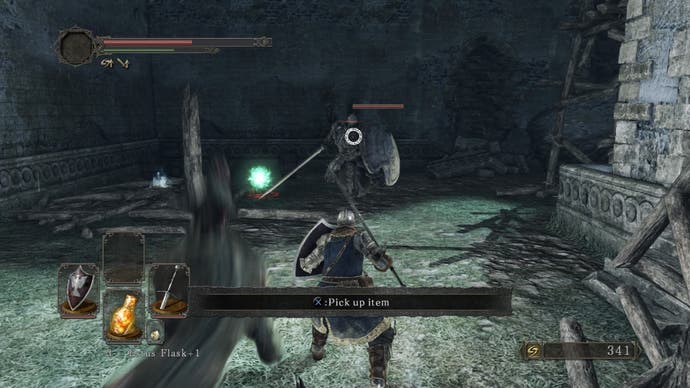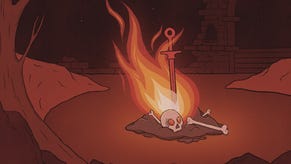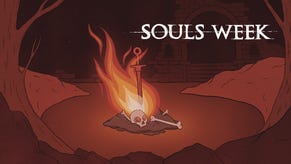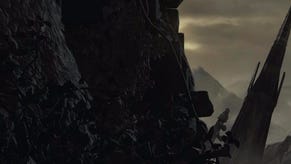Does Scholar of the First Sin make Dark Souls 2 worth returning to?
Like a moth drawn to a flame.
What curious - and many would say slightly misguided - timing it is that brings From Software's two most recent games head to head, with the Dark Souls 2 new generation remaster coming out only a week after the developer's PS4 debut Bloodborne. It's also a little unfortunate for Dark Souls 2; Souls fans have been putting Tomohiro Shibuya and Yui Tanimura's sequel up against Hidetaka Miyazaki's own entries ever since it came out last March, and the results have never really been in Dark Souls 2's favour.
It's worth pointing out, then, that Dark Souls 2 was and remains a very good game - and quite often a great one, even if it can't quite reach the heights of Demon's Souls, Dark Souls or Bloodborne. That much is underlined when coming to Scholar of the First Sin straight off the back of a playthrough of the frenzied, focussed fury of Bloodborne. After the endless aggression that's required to push through and beyond the streets of Yharnam, there's something soothing about the slow, soft clanking of iron armour, and in the relative calm to be found in a life lived peering over the top of a shield.
There's a period of readjustment, then, and after the streamlined nature of Bloodborne a sense of liberation. The options available to the player are vast, both in the walkways and stone paths that branch out from the serenity of Majula but also amidst the wall of stats, so often impenetrable, that define your character. In all of that there's a reminder of something I'd forgotten after just under a year away: Dark Souls 2 is an exceptionally broad game, spread out across a vast land but also where you're always shaping your character with the many tools at hand, and where you're always dizzy with the promise of where it'll take you next. It's a breadth that works for and against Dark Souls 2 - Miyazaki's games are dense with detail, and there's something both gained and lost in the scope of Drangleic.

Scholar of the First Sin notably makes Drangleic a more attractive land to wander, its boosted resolution and frame-rate matched by tweaks to the lighting engine that cast more impressive, deeper shadows across the land - all of which is being covered by Digital Foundry, both in its early performance analysis and with a more detailed face-off that's hitting the site soon. There's more to Scholar of the First Sin than a graphical remaster, though, and in its tinkering with enemy and item placement this is more of a remix; a Master Quest expansion to last year's original.
I'm not entirely sure the remix works entirely in Scholar of the First Sin's favour, over the opening dozen hours at least. Souls games often come alive in repeated playthroughs, where short-cuts and walkways become well-worn as you grind through familiar enemies, and where you patrol farming spots with the familiarity you have with the run to your local shops. This remix puts paid to all that, happily tripping you up with enemies in new places, or sometimes just more of them.
It's all well and good at maintaining an element of surprise for seasoned players, although too often the balance doesn't feel quite right. A once trying walk through Heide's Tower of Flame now becomes truly painful, with Heide Knights now perched on every corner, all too easily stirred from their resting state as they rush down on players. Take the far route through to the Cathedral of Blue and the path is now blocked by a dragon whose fireworks belie his slim life-bar, although it remains a stern challenge to hack away at it when pursued by the fistful of knights you've kited all the way there.
Souls games are famous for their challenge, of course, but I've always felt their appeal doesn't come in overcoming impossible odds but through the elegance of each encounter, and the fairness of each fight. There's a dignity in falling at the feet of Smough and Ornstein for the umpteenth time that isn't quite there in what Scholar of the First Sin throws at you, and the sense of unfairness isn't helped by some of the more punitive introductions. Weapons now crumble with alarming regularity, shattering between bonfires and quite often leaving you to face trying encounters with nothing more than a pocketful of broken daggers and axes. Whether the more limited durability of weapons is a bug or a feature in Scholar of the First Sin remains a matter of contention, though either way it's far from welcome.

Scholar of the First Sin's additions and amendments make it a less than ideal entry point for players new to the series, or indeed to Dark Souls 2. The often over-hyped difficulty level of the Souls games is very much real here, and if veterans of Drangleic are being wiped out by some of the surprises of Scholar of the First Sin then newcomers are likely to be obliterated.
There is hope, though. After too long spent struggling towards Dragonrider, the first boss in Heide's Tower of Flame, I decided to summon the help of other players, a tactic typically reserved for Dark Souls' more climactic encounters. That's when Scholar of the First Sin's new focus starts to click into place, and when you realise why the online player count has risen from four to six, and why some of those enemy mobs seem impossible to solo. This feels like a game designed to be played with someone always by your side, a shift in focus that fundamentally changes your approach to Drangleic.
To Scholar of the First Sin's credit, it's given Dark Souls 2 a new ability to surprise, even if it's also introduced some nasty shocks - Pursuers who spawn behind you in the moonlight of Bastille, say, or fallen bosses who are now resurrected and stalk later areas. They're changes that are unlikely to win Dark Souls 2 any new fans, and will have seasoned players switching off their consoles in frequent fits of frustration. As can often be the way in Souls games, though. If you're already addicted to that loop, it's likely you'll be wanting to come back to Scholar of the First Sin for more.









